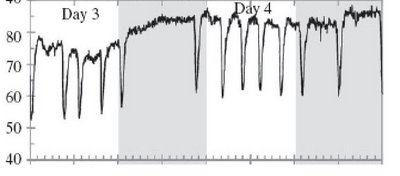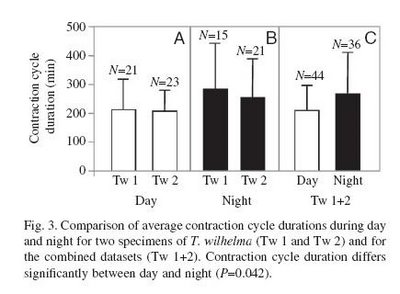Do sponges have circadian clocks?
 Short answer: nobody knows. Nobody has looked yet. Most of the research in biology is, quite rightfully, performed in just a handful of standard models. A sponge is not a standard animal lab model.
Short answer: nobody knows. Nobody has looked yet. Most of the research in biology is, quite rightfully, performed in just a handful of standard models. A sponge is not a standard animal lab model.Should one expect sponges to have circadian clock? Considering that every animal, plant, fungus and protist, as well as some bacteria have clocks, it would be more surprising if sponges did not have one.
I've been on a lookout, for quite some time now, for any mention in the literature of a possible daily rhythm in sponges. There is not much, but there is some. What is known for sure, is that both adult [1] and larval [2] sponges perceive light, thus they should be capable of entraining to the environmental light-dark cycles.
In the field, sponges release their larvae (spawn) in a manner that suggests that they a) can percieve environmetal light, b) use such information to calculate the time of day, and c) also have a lunar rhythm (either an endogenous circalunar clock entrained by the moon, or exogenous rhythm driven directly by moonlight):
Release started every day of 3 3-d period (12 to 14 October) at about 1400 hrs and lasted until just after sunset (1830 hrs). Ninety percent of the population showed reproductive activity. Exactly one lunar month later (11 to 12 November), a second release of gametes occurred. In the following year the same sequence of events was observed for the original population (2 to 4 October and 1 to 2 November, 1985). In all instances the first gamete release began on the third day after the full moon. These and earlier observations on this phenomenon show a strong correlation between moon phase and the time of gamete release [3].Another interesting behavior in sponges is called "pumping". Those are the contractions of the whole body of the sponge. Apparently [4], the contractions are slower during the night than during the day, indicating a diurnal, if not a circadian rhythm. Here is a pattern recorded from one sponge in the lab:
 Here is the light-to-dark comparison in two individual sponges:
Here is the light-to-dark comparison in two individual sponges: Locomotor activity is the most favored overt rhythm by researchers in chronobiology.
Locomotor activity is the most favored overt rhythm by researchers in chronobiology. If you did not know this before, sponges can move. Not fast enough to grab your ankle while swimming - more on the order of 6mm per day. This was a serendipitous finding a couple of decades ago, about a mile from where I live now, at UNC-Chapel Hill.
Calhoun Bond, then doing his PhD here (and now teaching at Greensboro College), happened to have an aquarium in his office. One day he looked at it and noticed that a sponge was not in the same place where it was before. So, he got a multi-million-dollar grant needed to buy a Sharpie pen [ ;-) ] and started drawing the position of the sponge on the glass wall of the aquarium. Yup, the sponge sure moved:

Dr.Bond has since published a couple of papers on the exact mechanim the sponge moves. It does not have a moving "leg" on the bottom. Instead, the whole animal rearranges itself as cells move over each other, pulling the spikules along. I've seen the stop-motion movies and they are impressive.
He has not noticed, though, if the sponge had different speeds during the day as opposed to during the night, but this could be easily done by an undegraduate student in a biology lab. Instead of drawing a mark once per day, draw a mark every 3-4 hours over a period of a couple of days, and the answer will be there. If there is a day/night difference in the sponge locomotion speed in a light-dark cycle, then it would be worth running the sponges through a standard battery of tests, including phase-shifts of the light-dark cycle, exposure to constant dark and constant light, and phase-shifting the rhythm with light pulses. This process could even be automated with a camera which can allow one to monitor the behavior over longer periods of time (e.g,. weeks or months).
 The study that most directly tested the effects of light-dark cycle on a behavior of a sponge looked, again, at the timing of spawning. Apparently [7], the sponge releases its larvae 24 hours after the last perceived dawn (i.e., light-to-dark transition) regardless of the light conditions transpiring during those 24 hours. This, in the wild, places the larval release right around the dawn of the next day.
The study that most directly tested the effects of light-dark cycle on a behavior of a sponge looked, again, at the timing of spawning. Apparently [7], the sponge releases its larvae 24 hours after the last perceived dawn (i.e., light-to-dark transition) regardless of the light conditions transpiring during those 24 hours. This, in the wild, places the larval release right around the dawn of the next day.One thing that I am surprised nobody did so far was to see if sponges have core circadian clock genes, like period, timeless, clock and cryptochrome. It is apprently relatively easy technically to do so. I have seen phylogenetic analyses of sequences of clock genes in dozens of, for instance, insect species. It can't be that hard to take a look at a sponge and, if teh clock genes are there, see in which cells and with what temporal dynamics they are expressed.
[1] Werner E.G. Muller, Klaus Wendt, Christopher Geppert, Matthias Wiens, Andreas Reiber, Heinz C. Schroder, Novel photoreception system in sponges? Unique transmission properties of the stalk spicules from the hexactinellid Hyalonema sieboldi, Biosensors and Bioelectronics 21 (2006) 1149–1155
[2] Sally P. Leys and Bernard M. Degnan, Cytological Basis of Photoresponsive Behavior in a Sponge Larva, Biol. Bull. 201: 323-338. (December 2001)
[3] W. F. Hoppe and M. J. M. Reichert, Predictable annual mass release of gametes by the coral reef sponge Neofibularia nolitangere (Porifera: Demospongiae), Marine Biology, Volume 94, Number 2, 277 - 285 (March 1987)
[4] Michael Nickel, Kinetics and rhythm of body contractions in the sponge Tethya wilhelma
(Porifera: Demospongiae), The Journal of Experimental Biology 207, 4515-4524
[5] CALHOUN BOND AND ALBERT K. HARRIS, Locomotion of Sponges and Its Physical Mechanism, THE JOURNAL OF EXPERIMENTAL ZOOLOGY 246:271-284 (1988)
[6] CALHOUN BOND, Continuous Cell Movements Rearrange Anatomical - Structures in Intact Sponges, THE JOURNAL OF EXPERIMENTAL ZOOLOGY 263:284-302 (1992)
[7] Amano, S, Morning release of larvae controlled by the light in an intertidal sponge, Callyspongia ramosa . Biological Bulletin, Marine Biological Laboratory, Woods Hole. Vol. 175, pp. 181-184. (1988).






1 Comments:
I don't understand all the science but I like browsing your great illustrations and skimming the text!
Post a Comment
<< Home